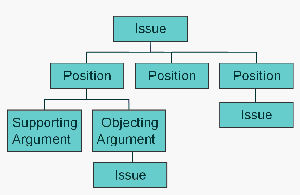
 |
Compsim Management Tools |
Compsim Management Tools (CMT) is a software application that runs on a Microsoft Windows based PC. It provides users a process to facilitate the collection and validation of information in order to make rational and explainable decisions. CMT enables the structuring of unstructured information and bridges the gap between "shot-from-the-hip" decision-making and formal decision-analysis. CMT can be used to "package" knowledge and decision-making models in a manner that allows them to be reused the future.
CMT can be applied wherever knowledge capture, decision-making, and/or scenario planning is needed.
The CMT process develops a decision tree. The process starts with a top level Issue or problem stated as a question. The statement of this top level Issue is a key part of the process. This textual definition needs to be "open-ended" to provide for a collection of information on the particular problem domain. Prompts are built into the system to assist in this phase. It is common to use terminology like:
What should be considered………….
How might one segment…………..
What options should be considered in order to……………
The user then responds to the Issue with Positions (or Options). Each of the Positions can be validated with Supporting or Objecting Arguments.
Positions or Arguments can spawn new Issues. All levels of the tree can be evaluated to show their importance. Reports are dynamically created based on the importance / priority of the information.

CMT provides a patented approach for graphically ranking and weighting information that is a key component to the decision-making process. The graphical approach equates well with subjective decision-making as judgment and reasoning are closer attuned to image processing functions than they are to number processing functions.
CMT supports group discussions related to the ranking and weighting of information. This is also helpful in management reviews. The users get immediate feedback during the review process, if there are any questions about the value or importance of information.
Since knowledge trees can become complex, CMT provides a variety of reporting and information sharing techniques. Output reports can be sent directly to a printer or can be saved in RTF (Rich Text Format), for publishing or for further editing in a word processor, HTML (Hyper Text Markup Language), for publishing on the internet as web pages, or as XML (Extensible Markup Language), for customized reporting or for use in a corporate knowledge base. Sample XSL (XML Style Sheets) are provided for porting the information to Excel.
Selective views of the knowledge trees can be created for focused reports.
CMT provides explainable decisions in a report format with graphs that can be copied directly into Microsoft PowerPoint or other presentation tools.
If the user agrees with the computer generated decision, the report can be used as backup for the user's decision. If the user disagrees with the generated decision, then the user can review the information that the computer used to develop the decision. Since the computer is completely objective in how it treats the information, it may be appropriate to rationalize any disagreements. The decision-making reports explain the decision in high level terms. These reports can be backed up with the full knowledge-base reports to provide a complete audit trail.
The CMT information structure is based on IBIS ("Issue Based Information System") proposed by Werner Kunz (Heidelberg, Germany) and Horst Rittel (Professor of the Science and Design, University of California, Berkley), in 1970. IBIS is an information organization technique. The assumption was that if information was collected and organized, then better decisions could be made. IBIS was developed to address "wicked" problems. Wicked problems are those for which there is no "correct" answer. With wicked problems, one is looking for a "best" answer. These are compared to "tame" problems. "Tame" problems are those addressed by scientists and engineers through the use of formulas. With formulas, one is after a "correct" answer. It is difficult or impossible to create a formula to address wicked problems. "
Compsim Management Tools can help organizations capture knowledge and/or make decisions that are auditable. Knowledge capture is now recognized as a key driver to the success of many companies. This is especially true for technology organizations where the domain knowledge of employees is critical to business success. When companies lose access to that knowledge, they lose significant funds they have invested to develop that knowledge capital. Compsim Management Tools is targeted at companies, organizations, and individuals that want decision making to be a core competency.
Compsim Management Tools can be applied wherever knowledge capture, decision-making, and/or scenario planning is needed. This would include processes such as:
| Compsim LLC PO Box 532 Brookfield, Wisconsin 53008 (262) 797-0418 |
Copyright © 2000-2005, Compsim LLC, All Rights Reserved